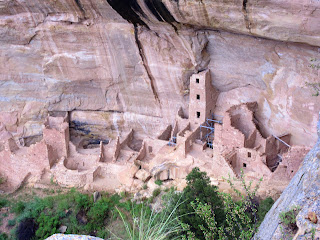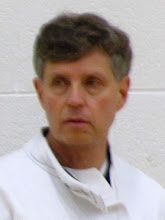The Wednesday before last we rose
early and drove to the Durango Airport to collect Mark and Michelle Watkins, friends
we haven’t seen in way too many years.
And as we hugged and bundled backpacks and luggage into the car it was
also as if we’d seen them yesterday. The
last time we were together we did Horseshoe Canyon and the San Rafael
Swell. This time we were headed for Mesa
Verde.
It could be the best way to make
sense of Mesa Verde would be with one of Edward Tufte’s clever strategies for
projecting high-dimensional objects into a diagram that would necessarily be a
map but something else, too. It was a
geographic center of civilization on the Colorado Plateau at a critical time,
the twelfth century, but it was also a cultural center, too, exporting
exquisite, geometric ceramic art to many other places in the Colorado Plateau
and importing exotic objects like Glymeris shell armbands from the Gulf of
Mexico. In an entirely different sense
it is a unique temporal nexus for the American Southwest. It was where cowboy history touched prehistory
on a snowy night in December 1888 when Richard Wetherhill discovered Cliff
Palace whilst looking for lost cattle. Wetherhill
also first hosted Gustaf Nordenskiöld, the Swedish Scholar who first brought a
professional practice of Archaeology to the Southwest. How many dimensions does that make? How do you draw a picture?
Then there are the cliff
dwellings.
We were insanely lucky. Cliff Palace, the largest and most famous
cliff dwelling, was closed for restoration.
The night we arrived rain thundered on the roof then, in the morning,
turned to snow on the Mesa. The result was
that our necessarily ranger-guided early hike to Balcony House only had 10
people. Did I mention how dangerous it
is to do Balcony House in those conditions?
The slippery, steep descent from the cliffs? The climb up a narrow, icy thirty foot ladder
to the site itself in shrieking winds?
The long dark passages with surprising drops and low doorways, some so
close you’re on hands and knees pushing your pack ahead of you with your nose? Well, actually, the weather broke just before
we began the hike so that while it was cool and a little damp, it was otherwise
beautiful. Further, the trail is more
than polite in almost any weather and the ladder was neither narrow nor icy,
though it is 30 feet high. The dark
passages, which are great fun, do exist.
Frankie Anderson, the ranger who led us was professional, very well
informed and gave us sufficient time to explore and photograph. As we were doing so, Mark commented that
cliff dweller culture must have shared aspects with contemporary Japanese
culture: the people must have been adept
at sharing close personal space and, perhaps, at developing an internal
psychological space as a counter balance.
Perhaps there were even similarities in etiquette. I’d glimpsed Anasazi culture from a new point
of view even though I’d been in Balcony House many times before. As far as I know, no one bumped his or her
head. And the climb out, though quicker,
was as fun as the one in.
In the afternoon we visited the park
museum, did the Soda Canyon hike which leads to an overlook of Balcony House
and also walked down to Spruce Tree House.
There we encountered Ranger Luann Andrew, who shared my perplexity at how
Craig Childs, the author/adventurer who wrote the admirable House of Rain about his pursuit of
Anasazi culture and prehistory, managed to get access to the back of the site,
almost 89 feet into the cliff face, which is always off limits. More interestingly, she gave us a
comprehensive tour of the remnants of the visual art on the ruin left by the
inhabitants as well as Nordenskiöld’s site number and James Wetherhill’s
initials.
Dinner at the lodge’s restaurant,
“the Metate Room,” was a disappointment.
We learned that the original chef had left and to my mind the new one
hasn’t found his footing yet; I hope he does so.
The sunset view of the rolling
green mesa and red rock canyons from the balcony patio and restaurant are one
of those glorious top of the world vistas.
It’s an archetypical vision of the West, its great distances and
cerulean and cumulous skies, suggesting promise, glory, mystery and loss. In the far distance Ship Rock stands on the
horizon like a ghostly castle. Though I
grew up far to the north, it’s one of those views that feels as much like home
as an old backyard. We forwent our usual
evening Bridge game for an early night.
The next morning we drove to the
Square Tower House Overlook where we met our guide for a hike down to the
Square Tower House itself. It was one of
the first hikes into the site since it had been closed for restoration and the
Park service only offers a half dozen or so every year, limiting those to less
than ten participants. Ironically, the
guide turned out to be the same Ranger Andrew we’d met yesterday. She appraised us while telling us what to
expect, decided we were fit enough for the trail and then we set off for the
descent. The first 20 foot ladder was
straightforward. The second came after a
short, but protected, ledge walk to stairs blasted into the rock in the 1920s
beside much shallower steps carved out of the rock by the original inhabitants. The transition from the rock stairs to the
ladder disappearing below looked tricky but turned out to be simple. After that it was a straight-forward back
country walk with the site slowly revealing itself through the Pinion and
Juniper forest before us.
Only half the site is visible
from the overlook above. What you don’t
see is the intricate multi-story construction into the cliff itself which rises
to a beautifully bricked rounded tower room called the Crow’s nest. I was so entranced by the architecture that I
didn’t do what I normally do at such sites, which is spend time ruminating
about how the site was built and what life was like here. Frankly, it was just too beautiful and mysterious. Next time.
Ranger Andrew turned out to be one of the best guides we’ve ever had in
the Park; she gave us an excellent précis of the site’s history and prehistory
and ensured we saw all of the rock art,
much of which is easily missed.
In the afternoon we did the Cliff
top Petroglyph trail, which was rather muddy from all the weather, and made it back
just as a another storm broke. We’d
hoped to do Wetherhill Mesa as well that day but it was closed due to lightning
danger. As we drove back to the lodge for
our last evening I was already missing Mesa Verde.
The next day we decamped for
Cortez and an afternoon at the Anasazi Heritage Center Museum which, next to
the Edge of the Cedars, has one of the best displays of Anasazi artifacts. Visiting either museum is always a wistful
and melancholy experience for me: I’m
always reminded of what’s lost, not just particular artifacts, but the
individual stories of the people themselves.
Their architecture, their migrations revealed in the archaeological
record and their art suggest a lost history which must have been rich, dramatic
and probably pertinent to the stresses our own culture faces.
In the evening, thanks to
recommendations made by two different people we’d met at Mesa Verde, we found
our way to the newly opened Loungin’ Lizard Restaurant in Cortez. It’s a project of the former chef at the Mesa
Verde Lodge, Brian Puett and his wife Amanda.
The chalk board menu, is definitely reminiscent of the one of the one he
created for Mesa Verde, but clearly aspires to take a step up in quality and
innovation. It’s a very pleasant space,
clearly frequented by the locals, including the proprietor of Drew Vineyards
who dropped by our table to introduce himself when he saw us enjoying one of
his wines. I recommend the Pork, the
Bison burger with Pork belly, the white chili and their root beer floats.
Monday we set out for some casual
hiking in Hovenweep and were once again graced with remarkable weather. We hiked in a particular light breeze beneath
uncertain clouds that reminded me of
adolescent adventures in the San Rafael Swell and Goblin Valley to the
west. So “I walked in shower of all my
days” to quote Dylan Thomas. The castle
like structures of Hovenweep, with circular towers similar to the construction
of the Crow’s Nest of Square Tower House in the mesa to the east suggest
cultural and technological coherence but there are enough differences to
suggest pluralism and diversity as well, especially when you consider the
nearby Lowry ruins site. A paper we’d
heard at the Big MACC Conference in March came to mind: Shanna Diederichs presented evidence
intimating that two cultural traditions may have lived concurrently side by
side at the Dillard site which was also not far away. The Anasazi, or Ancient Puebloans if you
prefer, are growing more complex and interesting the more we tease details from
what remains and that may be the only consolation for what’s lost.
Tuesday, we traveled east for a
short trip to Chimney Rock and the adjacent Chacoan Great House. Unfortunately, (and completely unnecessarily
to my mind) we had to make the hike with a group but the views from the top
were as spectacular as ever. The last
time we were there it was for a solstice moonrise between the pinnacles. Then it was back to Durango for Mexican food
and a last evening together at the rambling, nicely preserved Strater Hotel. After dinner, a helpful desk agent guided us
to an empty party room in the basement where we indulged ourselves with Ginger
Snaps, Dalwhinnie Scotch and Bridge.
Mark and I had consistently phenomenal hands; Michelle and Lynn, not so
much. In the next room, a group of local
Blue Grass enthusiasts played the night away.
I mostly listen to classical music and so that night I heard the Bob
Dylan/Ketch Secor song “Wagon Wheel” for the first time. It was lovely, as was so much of the music
they played.
In the morning I took one last
photo of the door of room 323, dedicated to Gustaf Nordenskiöld who’d been held
in the hotel by the sheriff for exporting artifacts even though there was no
law against it at that time. (According
to Ranger Andrew, that event subsequently led to the Antiquities Act of 1906.) Then it was time to take Mark and Michelle to
the airport and head home.
(And so we’re back; I will return
to the subject of Sir Thomas Malory shortly.)














1 comment:
What a wonderful trip. It was awesome seeing you guys, thanks for being such great tour guides! (my recollections here: http://www.viking2917.com/its-right-under-your-nose/
Post a Comment